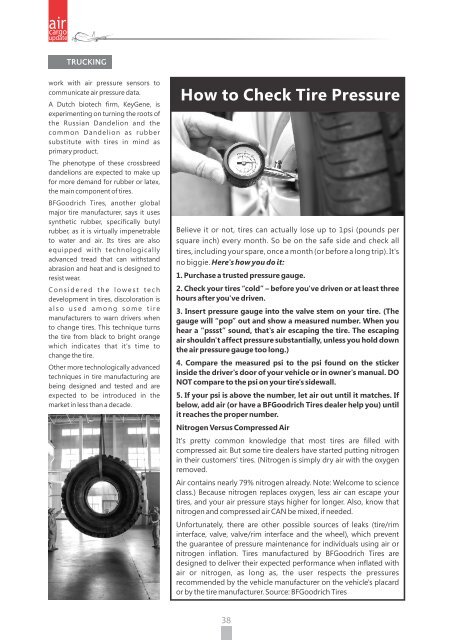Create successful ePaper yourself
Turn your PDF publications into a flip-book with our unique Google optimized e-Paper software.
TRUCKING<br />
work with air pressure sensors to<br />
communicate air pressure data.<br />
A Dutch biotech firm, KeyGene, is<br />
experimenting on turning the roots of<br />
the Russian Dandelion and the<br />
common Dandelion as rubber<br />
substitute with tires in mind as<br />
primary product.<br />
The phenotype of these crossbreed<br />
dandelions are expected to make up<br />
for more demand for rubber or latex,<br />
the main component of tires.<br />
BFGoodrich Tires, another global<br />
major tire manufacturer, says it uses<br />
synthetic rubber, specifically butyl<br />
rubber, as it is virtually impenetrable<br />
to water and air. Its tires are also<br />
equipped with technologically<br />
advanced tread that can withstand<br />
abrasion and heat and is designed to<br />
resist wear.<br />
C o n s i d e r e d t h e l o w e s t t e c h<br />
development in tires, discoloration is<br />
a l s o u s e d a m o n g s o m e t i r e<br />
manufacturers to warn drivers when<br />
to change tires. This technique turns<br />
the tire from black to bright orange<br />
which indicates that it's time to<br />
change the tire.<br />
Other more technologically advanced<br />
techniques in tire manufacturing are<br />
being designed and tested and are<br />
expected to be introduced in the<br />
market in less than a decade.<br />
How to Check Tire Pressure<br />
Believe it or not, tires can actually lose up to 1psi (pounds per<br />
square inch) every month. So be on the safe side and check all<br />
tires, including your spare, once a month (or before a long trip). It's<br />
no biggie. Here's how you do it:<br />
1. Purchase a trusted pressure gauge.<br />
2. Check your tires “cold” – before you've driven or at least three<br />
hours after you've driven.<br />
3. Insert pressure gauge into the valve stem on your tire. (The<br />
gauge will “pop” out and show a measured number. When you<br />
hear a “pssst” sound, that's air escaping the tire. The escaping<br />
air shouldn't affect pressure substantially, unless you hold down<br />
the air pressure gauge too long.)<br />
4. Compare the measured psi to the psi found on the sticker<br />
inside the driver's door of your vehicle or in owner's manual. DO<br />
NOT compare to the psi on your tire's sidewall.<br />
5. If your psi is above the number, let air out until it matches. If<br />
below, add air (or have a BFGoodrich Tires dealer help you) until<br />
it reaches the proper number.<br />
Nitrogen Versus Compressed Air<br />
It's pretty common knowledge that most tires are filled with<br />
compressed air. But some tire dealers have started putting nitrogen<br />
in their customers' tires. (Nitrogen is simply dry air with the oxygen<br />
removed.<br />
Air contains nearly 79% nitrogen already. Note: Welcome to science<br />
class.) Because nitrogen replaces oxygen, less air can escape your<br />
tires, and your air pressure stays higher for longer. Also, know that<br />
nitrogen and compressed air CAN be mixed, if needed.<br />
Unfortunately, there are other possible sources of leaks (tire/rim<br />
interface, valve, valve/rim interface and the wheel), which prevent<br />
the guarantee of pressure maintenance for individuals using air or<br />
nitrogen inflation. Tires manufactured by BFGoodrich Tires are<br />
designed to deliver their expected performance when inflated with<br />
air or nitrogen, as long as, the user respects the pressures<br />
recommended by the vehicle manufacturer on the vehicle's placard<br />
or by the tire manufacturer. Source: BFGoodrich Tires

















